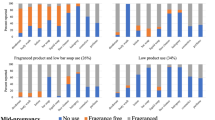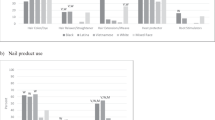Abstract
Background
Personal care products (PCPs) are an important source of endocrine disrupting chemicals (EDCs) linked to adverse reproductive health outcomes.
Objective
We evaluated EDC-associated PCP use and acculturation among Asian women.
Methods
Our study included 227 foreign-born Chinese women ages 18–45 seeking obstetrics-gynecology care at community health centers (Boston, MA). Acculturation was measured by English-language use, length of US residence, and age at US entry. Self-reported use of PCPs (crème rinse/conditioner, shampoo, perfume/cologne, bar soap/body wash, liquid hand soap, moisturizer/lotion, colored cosmetics, sunscreen, and nail polish) in the last 48 h was collected. Latent class analysis was used to identify usage patterns. We also conducted multivariable logistic to determine the cross-sectional associations of acculturation measures and the use of individual PCP types.
Results
Those who used more PCP types, overall and by each type, tended to be more acculturated. Women who could speak English had 2.77 (95% CI: 1.10–7.76) times the odds of being high PCP users compared to their non-English speaking counterparts. English-language use was associated with higher odds of using perfume/cologne and nail polish.
Significance
Our findings give insight about EDC-associated PCP use based on acculturation status, which can contribute to changes in immigrant health and health disparities.
This is a preview of subscription content, access via your institution
Access options
Subscribe to this journal
Receive 6 print issues and online access
$259.00 per year
only $43.17 per issue
Buy this article
- Purchase on Springer Link
- Instant access to full article PDF
Prices may be subject to local taxes which are calculated during checkout

Similar content being viewed by others
References
Budiman A, Cilluffo A, Ruiz NG. Key facts about Asian origin groups in the U.S. [Internet]. Pew Research Center. https://www.pewresearch.org/fact-tank/2019/05/22/key-facts-about-asian-origin-groups-in-the-u-s/.
Wang SS, Carreon JD, Gomez SL, Devesa SS. Cervical cancer incidence among 6 Asian Ethnic Groups in the United States, 1996 through 2004. Cancer. 2010;116:949–56.
Morey BN. Higher breast cancer risk among immigrant Asian American women than among US-born Asian American women. Prev Chronic Dis. 2019;16. https://www.cdc.gov/pcd/issues/2019/18_0221.htm.
Bryant AS, Worjoloh A, Caughey AB, Washington AE. Racial/ethnic disparities in obstetrical outcomes and care: prevalence and determinants. Am J Obstet Gynecol. 2010;202:335–43.
Pu J, Zhao B, Wang EJ, Nimbal V, Osmundson S, Kunz L, et al. Racial/ethnic differences in gestational diabetes prevalence and contribution of common risk factors. Paediatr Perinat Epidemiol. 2015;29:436–43.
Retnakaran R, Hanley AJG, Connelly PW, Sermer M, Zinman B. Ethnicity modifies the effect of obesity on insulin resistance in pregnancy: a comparison of Asian, South Asian, and Caucasian women. J Clin Endocrinol Metab. 2006;91:93–7.
Wan CS, Nankervis A, Teede H, Aroni R. Dietary intervention strategies for ethnic Chinese women with gestational diabetes mellitus: a systematic review and meta-analysis. Nutr Diet. 2019;76:211–32.
Xie K, Zhang Y, Wen J, Chen T, Kong J, Zhang J, et al. Genetic predisposition to gestational glucose metabolism and gestational diabetes mellitus risk in a Chinese population. J Diabetes. 2019;11:869–77.
Urquia ML, Glazier RH, Blondel B, Zeitlin J, Gissler M, Macfarlane A, et al. International migration and adverse birth outcomes: role of ethnicity, region of origin and destination. J Epidemiol Community Health. 2010;64:243–51.
Tapales A, Douglas-Hall A, Whitehead H. The sexual and reproductive health of foreign-born women in the United States. Contraception. 2018;98:47–51.
Singh GK, Yu SM. Adverse pregnancy outcomes: differences between US- and foreign-born women in major US racial and ethnic groups. Am J Public Health. 1996;86:837–43.
Mitro SD, Chu MT, Dodson RE, Adamkiewicz G, Chie L, Brown FM, et al. Phthalate metabolite exposures among immigrants living in the United States: findings from NHANES, 1999–2014. J Expo Sci Environ Epidemiol. 2019;29:71–82.
James-Todd TM, Meeker JD, Huang T, Hauser R, Ferguson KK, Rich-Edwards JW, et al. Pregnancy urinary phthalate metabolite concentrations and gestational diabetes risk factors. Environ Int. 2016;96:118–26.
Shaffer RM, Ferguson KK, Sheppard L, James-Todd T, Butts S, Chandrasekaran S, et al. Maternal urinary phthalate metabolites in relation to gestational diabetes and glucose intolerance during pregnancy. Environ Int. 2019;123:588–96.
Parlett LE, Calafat AM, Swan SH. Women’s exposure to phthalates in relation to use of personal care products. J Expo Sci Environ Epidemiol. 2013;23:197–206.
Hsieh C-J, Chang Y-H, Hu A, Chen M-L, Sun C-W, Situmorang RF, et al. Personal care products use and phthalate exposure levels among pregnant women. Sci Total Environ. 2019;648:135–43.
Keister LA, Vallejo JA, Aronson B. Chinese immigrant wealth: heterogeneity in adaptation. PLOS ONE 2016;11:e0168043.
Ro A. The longer you stay, the worse your health? A critical review of the negative acculturation theory among Asian immigrants. Int J Environ Res Public Health. 2014;11:8038–57.
Afable A, Yeh M-C, Trivedi T, Andrews E, Wylie-Rosett J. Duration of US residence and obesity risk in NYC Chinese immigrants. J Immigr Minor Health Cent Minor Public Health. 2016;18:624–35.
Oza-Frank R, Stephenson R, Venkat Narayan KM. Diabetes prevalence by length of residence among US immigrants. J Immigr Minor Health. 2011;13:1–8.
Chen L. Influence of acculturation on risk for gestational diabetes among asian women. Prev Chronic Dis. 2019;16. https://www.cdc.gov/pcd/issues/2019/19_0212.htm.
Hedderson MM, Darbinian JA, Ferrara A. Disparities in the risk of gestational diabetes by race-ethnicity and country of birth: gestational diabetes and race/ethnicity. Paediatr Perinat Epidemiol. 2010;24:441–8.
Health Resources & Services Administration. 2018 South Cove Community Health Ctr, Inc. Health Center Program Awardee Data. https://bphc.hrsa.gov/uds/datacenter.aspx?q=d&bid=010710&state=MA&year=2018.
US Census Bureau. American Community Survey (ACS) [Internet]. The United States Census Bureau. https://www.census.gov/programs-surveys/acs.
Allen JD, Caspi C, Yang M, Leyva B, Stoddard AM, Tamers S, et al. Pathways between acculturation and health behaviors among residents of low-income housing: the mediating role of social and contextual factors. Soc Sci Med. 2014;123:26–36.
Smith GJ Douglas S Massey, Mark R Rosenzweig, and James P. The new immigrant survey in the U.S.: the experience over time. migrationpolicy.org. 2003. https://www.migrationpolicy.org/article/new-immigrant-survey-us-experience-over-time.
Braun JM, Just AC, Williams PL, Smith KW, Calafat AM, Hauser R. Personal care product use and urinary phthalate metabolite and paraben concentrations during pregnancy among women from a fertility clinic. J Expo Sci Environ Epidemiol. 2014;24:459–66.
O’Brien MJ. Acculturation and the prevalence of diabetes in US Latino adults, national health and nutrition examination survey 2007–2010. Prev Chronic Dis. 2014;11:E176. Available from: https://www.cdc.gov/pcd/issues/2014/14_0142.htm.
Koya DL, Egede LE. Association between length of residence and cardiovascular disease risk factors among an ethnically diverse group of United States immigrants. J Gen Intern Med. 2007;22:841–6.
Commodore‐Mensah Yvonne, Ukonu Nwakaego, Obisesan Olawunmi, Aboagye Jonathan Kumi, Agyemang Charles, Reilly Carolyn M, et al. Length of residence in the united states is associated with a higher prevalence of cardiometabolic risk factors in immigrants: a contemporary analysis of the national health interview survey. J Am Heart Assoc. 5:e004059.
National Institute of Environmental Health Sciences. Endocrine Disruptors. National Institute of Environmental Health Sciences. https://www.niehs.nih.gov/health/topics/agents/endocrine/index.cfm.
Weatherly LM, Gosse JA. Triclosan exposure, transformation, and human health effects. J Toxicol Environ Health Part B 2017;20:447–69.
Linzer DA, Lewis JB. poLCA: an R Package for polytomous variable latent class analysis. J Stat Softw. 2011;42:1–29.
Azur MJ, Stuart EA, Frangakis C, Leaf PJ. Multiple imputation by chained equations: what is it and how does it work? Multiple imputation by chained equations. Int J Methods Psychiatr Res. 2011;20:40–9.
Benjamin S, Masai E, Kamimura N, Takahashi K, Anderson RC, Faisal PA. Phthalates impact human health: epidemiological evidences and plausible mechanism of action. J Hazard Mater. 2017;340:360–83.
Holland N, Huen K, Tran V, Street K, Nguyen B, Bradman A, et al. Urinary phthalate metabolites and biomarkers of oxidative stress in a Mexican-American cohort: variability in early and late pregnancy. Toxics 2016;4:7.
Berry JW. Immigration, acculturation, and adaptation. Appl Psychol. 1997;46:5–34.
Moore KA, Weinberg BD, Berger PD. The mitigating effects of acculturation on consumer behavior. Int J Bus Soc Sci.2012;3:5
Berry JW. A psychology of immigration. J Soc Issues. 2001;57:615–31.
Segev S, Ruvio A, Shoham A, Velan D. Acculturation and consumer loyalty among immigrants: a cross-national study. Eur J Mark. 2014;48:1579–99.
Zota AR, Shamasunder B. The environmental injustice of beauty: framing chemical exposures from beauty products as a health disparities concern. Am J Obstet Gynecol. 2017;217:418.e1–e6.
Bloom MS, Wenzel AG, Brock JW, Kucklick JR, Wineland RJ, Cruze L, et al. Racial disparity in maternal phthalates exposure; association with racial disparity in fetal growth and birth outcomes. Environ Int. 2019;127:473–86.
James-todd T, Senie R, Terry MB. Racial/ethnic differences in hormonally-active hair product use: a plausible risk factor for health disparities. J Immigr Minor Health N. Y 2012;14:506–11.
Taylor KW, Baird DD, Herring AH, Engel LS, Nichols HB, Sandler DP, et al. Associations among personal care product use patterns and exogenous hormone use in the NIEHS Sister Study. J Expo Sci Environ Epidemiol. 2017;27:458–64.
Gaston SA, James-Todd T, Harmon Q, Taylor KW, Baird D, Jackson CL. Chemical/straightening and other hair product usage during childhood, adolescence, and adulthood among African-American women: potential implications for health. J Expo Sci Environ Epidemiol. 2020;30:86–96.
James-Todd TM, Chiu Y-H, Zota AR. Racial/ethnic disparities in environmental endocrine disrupting chemicals and women’s reproductive health outcomes: epidemiological examples across the life course. Curr Epidemiol Rep. 2016;3:161–80.
James-Todd T, Meeker J, Huang T, Hauser R, Seely E, Ferguson K, et al. Racial and ethnic variations in phthalate metabolite concentrations across pregnancy. J Expo Sci Environ Epidemiol. 2017;27:160–6.
Mitro SD, Chu MT, Dodson RE, Adamkiewicz G, Chie L, Brown FM, et al. Phthalate metabolite exposures among immigrants living in the United States: findings from NHANES, 1999–2014. J Expo Sci Environ Epidemiol. 2019;29:71–82.
Guo Y, Alomirah H, Cho H-S, Minh TB, Mohd MA, Nakata H, et al. Occurrence of phthalate metabolites in human urine from several Asian countries. Environ Sci Technol. 2011;45:3138–44.
Tsang S, Royse CF, Terkawi AS. Guidelines for developing, translating, and validating a questionnaire in perioperative and pain medicine. Saudi J Anaesth. 2017;11:S80–9.
Kandula NR, Diez-Roux AV, Chan C, Daviglus ML, Jackson SA, Ni H, et al. Association of acculturation levels and prevalence of diabetes in the Multi-Ethnic Study of Atherosclerosis (MESA). Diabetes Care. 2008;31:1621–8.
Benet-Martínez V, Haritatos J. Bicultural identity integration (BII): components and psychosocial antecedents. J Pers. 2005;73:1015–49.
Suinn R, Rickard-Figueroa K, Lew S, Vigil P. The Suinn-Lew Asian Self-Identity Acculturation Scale: an initial report. Educ Psychol Meas. 1987;47:401–7.
Tsai JL. General Ethnicity Questionnaire|Culture and emotion lab. https://culture-emotion-lab.stanford.edu/projects/toolsmaterials/general-ethnicity-questionnaire.
Acknowledgements
We offer our special thanks to the participants and leadership of South Cove Community Health Center in Chinatown, MA and Quincy, MA.
Funding
This study was supported by grant NIH/NIEHS T32ES007069, P30ES000002, R01ES026166. This work was funded, in part, by the Intramural Program at the National Institutes of Health (NIH), National Institute of Environmental Health Sciences (NIEHS, Z1AES103325–01).
Author information
Authors and Affiliations
Corresponding author
Ethics declarations
Conflict of interest
The authors declare that they have no conflict of interest.
Additional information
Publisher’s note Springer Nature remains neutral with regard to jurisdictional claims in published maps and institutional affiliations.
Supplementary information
Rights and permissions
About this article
Cite this article
Wang, V.A., Chu, M.T., Chie, L. et al. Acculturation and endocrine disrupting chemical-associated personal care product use among US-based foreign-born Chinese women of reproductive age. J Expo Sci Environ Epidemiol 31, 224–232 (2021). https://doi.org/10.1038/s41370-020-00279-0
Received:
Revised:
Accepted:
Published:
Issue Date:
DOI: https://doi.org/10.1038/s41370-020-00279-0
Keywords
This article is cited by
-
Differences in personal care product use by race/ethnicity among women in California: implications for chemical exposures
Journal of Exposure Science & Environmental Epidemiology (2023)
-
Methods in Public Health Environmental Justice Research: a Scoping Review from 2018 to 2021
Current Environmental Health Reports (2023)
-
The mediating role of telomere length in multi-pollutant exposure associated with metabolic syndrome in adults
Environmental Science and Pollution Research (2023)
-
Impacts of endocrine disruptors on reproductive health in the era of increased personal care and beauty products usage
Bulletin of the National Research Centre (2022)
-
Chemicals of concern in personal care products used by women of color in three communities of California
Journal of Exposure Science & Environmental Epidemiology (2022)



